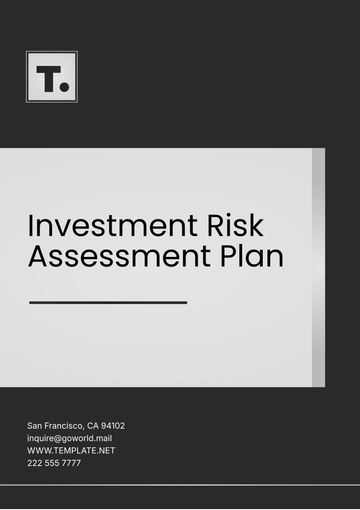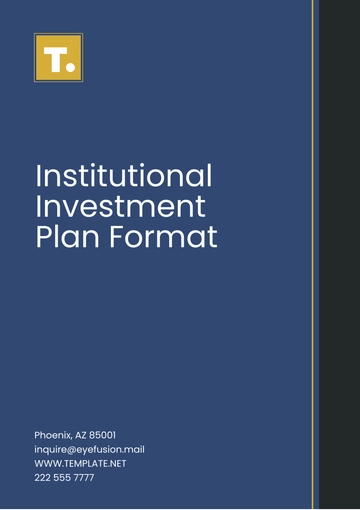Free Pension Fund Investment Plan

I. Executive Summary
This Pension Fund Investment Plan establishes the strategic approach for effectively managing a pension fund to achieve sustainable growth, optimize returns, and mitigate risks. It provides a detailed overview of the current investment landscape, offers future economic and financial projections, and outlines structured investment strategies. This plan emphasizes prudent governance, regulatory compliance, and ongoing performance review to ensure the fund’s stability and reliability in meeting its long-term obligations.
II. Investment Objectives
A. Long-Term Capital Appreciation
The primary objective is to achieve long-term capital appreciation that will enable the fund to meet its future obligations. A diversified approach to asset allocation will be pursued, in alignment with the fund’s risk tolerance and return expectations, to ensure that the fund grows sustainably over time.
B. Risk Management and Preservation of Capital
Comprehensive risk management practices are integral to preserving the fund’s capital. This includes employing rigorous portfolio reviews, risk assessments, and adjustments in response to market volatility to sustain fund stability and minimize potential losses.
C. Income Generation
A consistent income stream will be targeted to cover the fund’s short-term liabilities and operational expenses without detracting from growth objectives. The fund will focus on income-producing assets that align with both its liquidity needs and overall growth goals.
D. Inflation Protection
To protect the purchasing power of the fund’s assets over time, the investment strategy will include inflation-hedging components, such as inflation-linked bonds and real assets, which can provide stable returns adjusted for inflationary pressures.
III. Asset Allocation Strategy
A. Equities (Total: 50%)
Equities will be a central component of the portfolio, providing potential for growth through both domestic and international stock markets, with emphasis on sectoral and geographic diversification.
Domestic Equities: 30%
International Equities: 20%
B. Fixed Income Securities (Total: 35%)
Fixed-income assets will provide income and stability. The fund will allocate a portion to government and corporate bonds to reduce volatility and generate steady returns.
Government Bonds: 20%
Corporate Bonds: 15%
C. Real Estate and Alternative Investments (Total: 15%)
Diversification will extend into real assets and alternative investments, offering opportunities for additional growth and income generation.
Real Estate: 10%
Alternative Investments: 5% (including private equity, hedge funds, and commodities)
D. Cash and Cash Equivalents (Target Allocation: 5%)
A reserve of cash and short-term equivalents will be maintained to meet liquidity needs, enabling swift responses to market opportunities or liabilities.
IV. Implementation Strategies
A. Active and Passive Management
A blended management approach will be applied: active management in asset classes where excess returns can be achieved, complemented by passive management in efficient markets to maintain cost efficiency.
B. Strategic vs. Tactical Asset Allocation
Strategic Asset Allocation: The fund will adhere to a long-term strategic asset mix based on its risk-return profile while remaining flexible to adjustments.
Tactical Asset Allocation: In response to short-term market conditions, tactical shifts will be made within defined parameters to leverage market opportunities and control risk exposure.
C. Responsible and ESG Investing
Integrating Environmental, Social, and Governance (ESG) criteria into the investment decision-making process will help align the fund with responsible investment principles, contributing to risk management and value creation over the long term.
V. Monitoring, Performance Evaluation, and Review
A. Performance Metrics and Benchmarking
The fund will be evaluated regularly against relevant benchmarks and industry standards. Key metrics will include return on investment (ROI), risk-adjusted returns, and income generation, alongside ESG impact metrics where applicable.
B. Periodic Rebalancing
To maintain the target asset allocation and manage the portfolio’s risk profile, the fund will undergo periodic rebalancing. This will involve adjusting positions in assets that have overperformed or underperformed relative to the strategic allocation.
C. Stress Testing and Scenario Analysis
Periodic stress testing and scenario analysis will be conducted to assess the fund’s resilience under adverse market conditions and potential economic scenarios. This helps prepare for unexpected changes and informs potential adjustments.
VI. Governance, Oversight, and Compliance
A. Governance Structure
An independent board of trustees will provide oversight of the fund, supported by an investment committee and compliance officer to ensure robust management. These roles are critical to maintaining transparency, accountability, and effective stewardship of the fund’s assets.
B. Regulatory and Legal Compliance
The fund will comply with all regulatory standards and adhere to legal requirements as outlined by financial authorities. This will include regular reporting, audits, and reviews to uphold the ethical management of the fund.
C. Fiduciary Responsibility
Ensuring fiduciary responsibility is paramount. The board, trustees, and investment managers will act in the best interest of beneficiaries, with a commitment to ethical standards, prudent decision-making, and transparent communication.
VII. Conclusion
This Pension Fund Investment Plan provides a structured and strategic approach to pension fund management. Through diversified asset allocation, sound risk management practices, and proactive governance, the fund is well-positioned to achieve its objectives of capital growth, income generation, and long-term stability. Regular reviews and adjustments, aligned with evolving market conditions and regulatory requirements, will ensure the fund remains resilient and sustainable for the benefit of its beneficiaries.
- 100% Customizable, free editor
- Access 1 Million+ Templates, photo’s & graphics
- Download or share as a template
- Click and replace photos, graphics, text, backgrounds
- Resize, crop, AI write & more
- Access advanced editor
You may also like
- Finance Plan
- Construction Plan
- Sales Plan
- Development Plan
- Career Plan
- Budget Plan
- HR Plan
- Education Plan
- Transition Plan
- Work Plan
- Training Plan
- Communication Plan
- Operation Plan
- Health And Safety Plan
- Strategy Plan
- Professional Development Plan
- Advertising Plan
- Risk Management Plan
- Restaurant Plan
- School Plan
- Nursing Home Patient Care Plan
- Nursing Care Plan
- Plan Event
- Startup Plan
- Social Media Plan
- Staffing Plan
- Annual Plan
- Content Plan
- Payment Plan
- Implementation Plan
- Hotel Plan
- Workout Plan
- Accounting Plan
- Campaign Plan
- Essay Plan
- 30 60 90 Day Plan
- Research Plan
- Recruitment Plan
- 90 Day Plan
- Quarterly Plan
- Emergency Plan
- 5 Year Plan
- Gym Plan
- Personal Plan
- IT and Software Plan
- Treatment Plan
- Real Estate Plan
- Law Firm Plan
- Healthcare Plan
- Improvement Plan
- Media Plan
- 5 Year Business Plan
- Learning Plan
- Marketing Campaign Plan
- Travel Agency Plan
- Cleaning Services Plan
- Interior Design Plan
- Performance Plan
- PR Plan
- Birth Plan
- Life Plan
- SEO Plan
- Disaster Recovery Plan
- Continuity Plan
- Launch Plan
- Legal Plan
- Behavior Plan
- Performance Improvement Plan
- Salon Plan
- Security Plan
- Security Management Plan
- Employee Development Plan
- Quality Plan
- Service Improvement Plan
- Growth Plan
- Incident Response Plan
- Basketball Plan
- Emergency Action Plan
- Product Launch Plan
- Spa Plan
- Employee Training Plan
- Data Analysis Plan
- Employee Action Plan
- Territory Plan
- Audit Plan
- Classroom Plan
- Activity Plan
- Parenting Plan
- Care Plan
- Project Execution Plan
- Exercise Plan
- Internship Plan
- Software Development Plan
- Continuous Improvement Plan
- Leave Plan
- 90 Day Sales Plan
- Advertising Agency Plan
- Employee Transition Plan
- Smart Action Plan
- Workplace Safety Plan
- Behavior Change Plan
- Contingency Plan
- Continuity of Operations Plan
- Health Plan
- Quality Control Plan
- Self Plan
- Sports Development Plan
- Change Management Plan
- Ecommerce Plan
- Personal Financial Plan
- Process Improvement Plan
- 30-60-90 Day Sales Plan
- Crisis Management Plan
- Engagement Plan
- Execution Plan
- Pandemic Plan
- Quality Assurance Plan
- Service Continuity Plan
- Agile Project Plan
- Fundraising Plan
- Job Transition Plan
- Asset Maintenance Plan
- Maintenance Plan
- Software Test Plan
- Staff Training and Development Plan
- 3 Year Plan
- Brand Activation Plan
- Release Plan
- Resource Plan
- Risk Mitigation Plan
- Teacher Plan
- 30 60 90 Day Plan for New Manager
- Food Safety Plan
- Food Truck Plan
- Hiring Plan
- Quality Management Plan
- Wellness Plan
- Behavior Intervention Plan
- Bonus Plan
- Investment Plan
- Maternity Leave Plan
- Pandemic Response Plan
- Succession Planning
- Coaching Plan
- Configuration Management Plan
- Remote Work Plan
- Self Care Plan
- Teaching Plan
- 100-Day Plan
- HACCP Plan
- Student Plan
- Sustainability Plan
- 30 60 90 Day Plan for Interview
- Access Plan
- Site Specific Safety Plan





























